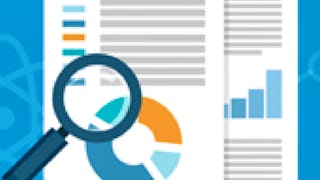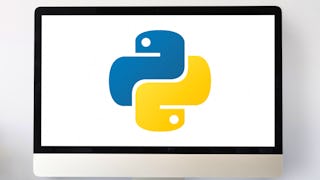This Statistics for Data Science course is designed to introduce you to the basic principles of statistical methods and procedures used for data analysis. After completing this course you will have practical knowledge of crucial topics in statistics including - data gathering, summarizing data using descriptive statistics, displaying and visualizing data, examining relationships between variables, probability distributions, expected values, hypothesis testing, introduction to ANOVA (analysis of variance), regression and correlation analysis. You will take a hands-on approach to statistical analysis using Python and Jupyter Notebooks – the tools of choice for Data Scientists and Data Analysts.

Enjoy unlimited growth with a year of Coursera Plus for $199 (regularly $399). Save now.

Statistics for Data Science with Python
This course is part of Data Science Fundamentals with Python and SQL Specialization


Instructors: Murtaza Haider
42,126 already enrolled
Included with
(452 reviews)
What you'll learn
Write Python code to conduct various statistical tests including a T test, an ANOVA, and regression analysis.
Interpret the results of your statistical analysis after conducting hypothesis testing.
Calculate descriptive statistics and visualization by writing Python code.
Create a final project that demonstrates your understanding of various statistical test using Python and evaluate your peer's projects.
Skills you'll gain
- Data Visualization
- Data Science
- Statistics
- Pandas (Python Package)
- Probability & Statistics
- Statistical Hypothesis Testing
- Exploratory Data Analysis
- Statistical Analysis
- Matplotlib
- Jupyter
- Descriptive Statistics
- Regression Analysis
- Data Analysis
- Statistical Methods
- Probability
- Probability Distribution
- Correlation Analysis
- Scientific Visualization
Details to know

Add to your LinkedIn profile
6 quizzes, 6 assignments
See how employees at top companies are mastering in-demand skills

Build your subject-matter expertise
- Learn new concepts from industry experts
- Gain a foundational understanding of a subject or tool
- Develop job-relevant skills with hands-on projects
- Earn a shareable career certificate

There are 9 modules in this course
Welcome!
What's included
2 videos2 readings1 app item
This module will focus on introducing the basics of descriptive statistics - mean, median, mode, variance, and standard deviation. It will explain the usefulness of the measures of central tendency and dispersion for different levels of measurement.
What's included
4 videos2 quizzes1 app item
This module will focus on different types of visualization depending on the type of data and information we are trying to communicate. You will learn to calculate and interpret these measures and graphs.
What's included
4 videos2 quizzes1 app item
This module will introduce the basic concepts and application of probability and probability distributions.
What's included
5 videos2 readings2 quizzes1 app item
This module will focus on teaching the appropriate test to use when dealing with data and relationships between them. It will explain the assumptions of each test and the appropriate language when interpreting the results of a hypothesis test.
What's included
5 videos2 assignments1 app item
This module will dive straight into using python to run regression analysis for testing relationships and differences in sample and population means rather than the classical hypothesis testing and how to interpret them.
What's included
4 videos2 assignments1 app item
In the final week of the course, you will be given a dataset and a scenario where you will use descriptive statistics and hypothesis testing to give some insights about the data you were provided. You will make a submission of the final project notebook for evaluation.
What's included
1 reading1 peer review2 app items1 plugin
What's included
1 assignment
Cheat sheet for Statistics in Python
What's included
1 reading1 assignment1 plugin
Earn a career certificate
Add this credential to your LinkedIn profile, resume, or CV. Share it on social media and in your performance review.
Instructors


Offered by
Explore more from Probability and Statistics
Why people choose Coursera for their career




Learner reviews
452 reviews
- 5 stars
69.24%
- 4 stars
19.91%
- 3 stars
5.30%
- 2 stars
2.65%
- 1 star
2.87%
Showing 3 of 452
Reviewed on Apr 4, 2021
I highly recommend this course for anyone that is having problems with basic statisitcs.
Reviewed on Apr 6, 2021
Reviewed on Jun 10, 2022
A very good course to clear the basics pf stat of statistics for data science

Open new doors with Coursera Plus
Unlimited access to 10,000+ world-class courses, hands-on projects, and job-ready certificate programs - all included in your subscription
Advance your career with an online degree
Earn a degree from world-class universities - 100% online
Join over 3,400 global companies that choose Coursera for Business
Upskill your employees to excel in the digital economy
Frequently asked questions
To access the course materials, assignments and to earn a Certificate, you will need to purchase the Certificate experience when you enroll in a course. You can try a Free Trial instead, or apply for Financial Aid. The course may offer 'Full Course, No Certificate' instead. This option lets you see all course materials, submit required assessments, and get a final grade. This also means that you will not be able to purchase a Certificate experience.
When you enroll in the course, you get access to all of the courses in the Specialization, and you earn a certificate when you complete the work. Your electronic Certificate will be added to your Accomplishments page - from there, you can print your Certificate or add it to your LinkedIn profile.
Yes. In select learning programs, you can apply for financial aid or a scholarship if you can’t afford the enrollment fee. If fin aid or scholarship is available for your learning program selection, you’ll find a link to apply on the description page.
More questions
Financial aid available,





